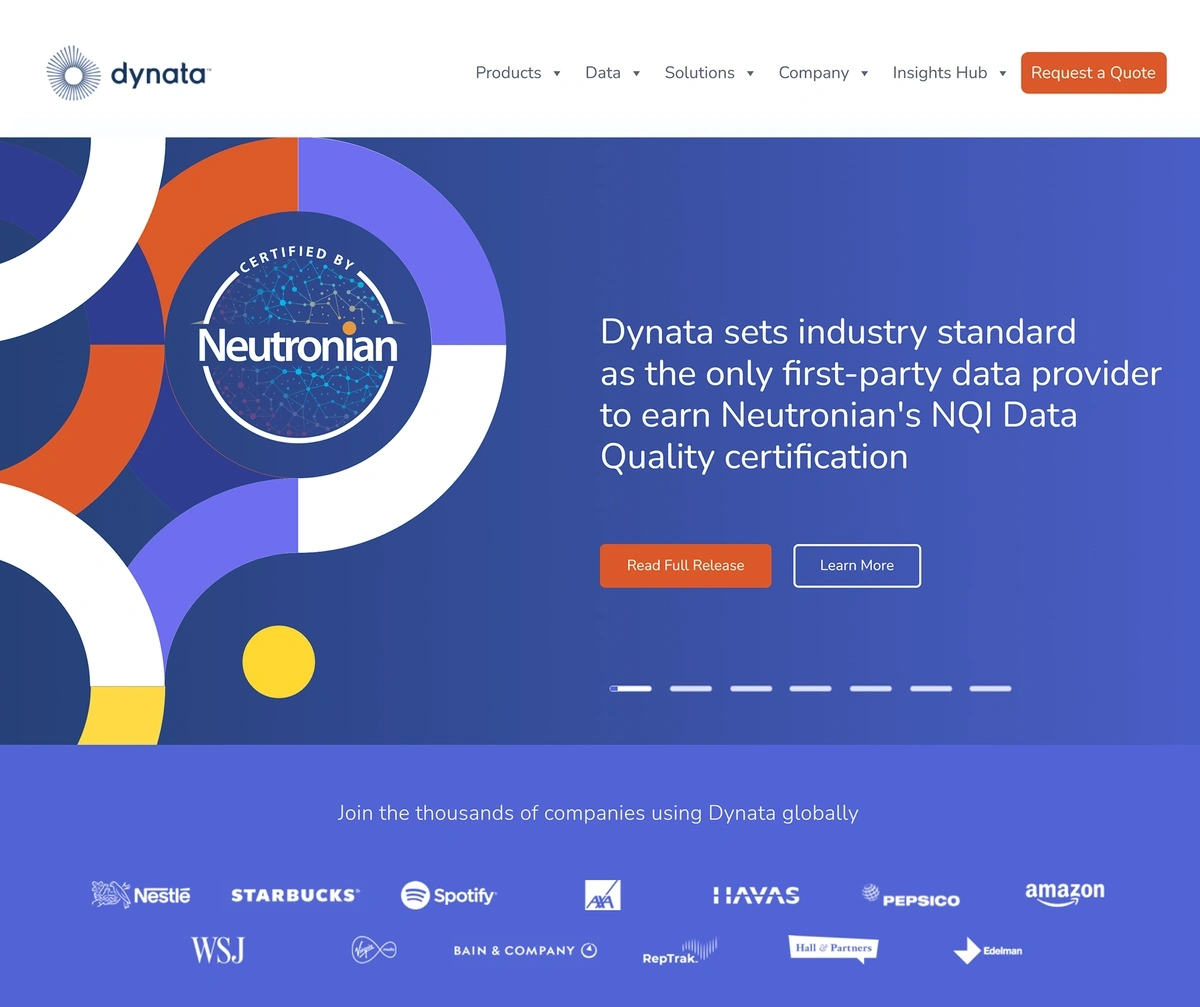
7 Top B2B Market Research Tools (2024)
Ultimately, the best B2B market research tool for your needs will provide quantitative or qualitative data on:
- Trends that are important to B2B buyers and key decision-makers
- B2B customers’ needs
- Key competitors in your B2B market
- Potential economic factors with an impact on your industry
- How your audience views your products or services
These seven B2B market research tools are a great place to start, as they offer a mix of data, features and ideal use cases at various price points.
1. Exploding Topics
Exploding Topics is a trend spotting tool that does a solid job of identifying growing B2B trends.
You can also use it to:
- Discover new competitors
- See what kind of funding startup competitors or clients have received to date
- Learn more about products launching—and selling—in your market
- See how interest in different trends has fluctuated over the past 15 years
- See a projection of how a topic may trend over the next 12 months
This means that you can use Exploding Topics during the market research process to support your:
- Product development
- Content marketing
- Sales
- Customer outreach
Plus, we update our trend database every day. There’s no waiting for panel respondents to get back to you or trying to estimate how data may have changed since a report’s publication date—it’s always fresh.
We’re able to do this thanks to a blend of AI tools and human data analysis.
First, our AI “listens” to conversations online—across forums, websites, news reports, and other places your B2B customers may gather—and identifies the topics people are currently talking about.
Then, our data analysis team reviews the trends and decides what’s going to be most useful to our users.
You can explore our database on your own, or read through insightful reports that our team puts together regularly.
We make a portion of this information free for anyone to browse—to get access to all our features, including instant reports on the topics that are most important to you, you’ll need an Exploding Topics Pro subscription.
2. Wynter
Wynter helps companies quickly and effectively test their brand messaging.
When using Wynter, you'll have access to a group of B2B customers that are similar to your target audience.
You can then leverage this group to:
- Evaluate potential customer satisfaction around new launches
- Survey people similar to your target audience
- Get recordings of audience testers interacting with your website
- Allow audience voting on different options
The way it works is simple: Wynter maintains a database of B2B professionals that they’ve scouted through various industry outlets. Each person’s credentials are checked against their LinkedIn profile, and they receive payment for taking part in tests.
As a Wynter user, you can tap into this database and build focus groups based on demographic data about your target market:
- Company size
- Industry
- Job title
- Seniority
Each focus group may contain between 15 and 30 people, and you’ll have results in 12 to 72 hours.
To use all of Wynter’s segmentation and testing features, you’ll need to subscribe to a paid plan, which starts at $6.9k per year.
Pay-as-you-go options are also available.
3. QualtricsXM
The QualtricsXM market research platform lets you build your own panels by recruiting from groups like your:
- Email subscribers
- Website visitors
- Social media followers
Once recruited, you can track the activities and feedback of each person in a panel—and reward them for their participation.
With these audiences, you can then:
- Run surveys
- Get feedback on new products
- Analyze purchase behavior
- Conduct A/B tests
- Assess audience ad perception
- Test website optimization
If you don’t want to use your own customers for panels, or don’t have a large following, you can also purchase access to target audience groups assembled by Qualtrics.
QualtricsXM uses a custom pricing model, so you’ll need to get in touch with their sales team for a demo and a price quote.
4. Statista
Statista provides global market research statistics for 170 industries, including:
- Advertising
- Agriculture
- Construction
- Energy
- Media
- Real Estate
- Telecommunications
- Transportation
The core of the platform is its searchable database, which includes reports and infographics. You can use this database for in-depth research on:
- Projected market growth in over 190 regions
- The makeup of over 100 private and public companies
- Key performance metrics for leading e-commerce companies
- Various political topics and societal issues that may influence business
Statista offers limited free access to its charts and graphs. To access the entire stats database—and download data in multiple formats—you’ll need a paid plan. Subscription options start at $99 per month (billed annually). Some Statista research reports may still incur an additional cost to purchase.
5. Semrush
Semrush is a digital marketing tool often used for search engine optimization—but it also has market research capabilities.
You can use Semrush to:
- Research your market share and see your biggest competitors
- Estimate how much traffic your competitors’ websites get
- Find out what kind of content your competitors and target customers are creating
- Track competitors’ online mentions
- Analyze your competitors’ ads
- Post social content to various platforms frequented by your potential customers
The platform offers a few limited competitor and keyword searches per month, but to unlock the full power of Semrush for market research you’ll need to pick a paid plan. These plans start at $129.95 per month, or $108.33 per month when billed annually.
6. The Census Bureau
The Census Bureau is well known for surveying U.S. households every 10 years, but it’s also responsible for compiling business data.
Entrepreneurs, small businesses, trade organizations, wholesalers, exporters, and more respond to Census Bureau questionnaires every year.
You can explore the Census Bureau’s data to build a picture of how your competitors and target customers operate. This data includes market insights like:
- The businesses operating in a specific region
- Economic factors affecting business activity
- Management trends across different industries
- Changes in employment rates
- Manufacturing rates
There’s no cost to access Census Bureau data. It only pertains to U.S. businesses, though. If you need to research markets in other countries, then the Bureau isn’t the best option for you.
7. Dynata
Dynata is a first-party data provider with access to information about 70 million consumers and business customers.
When using Dyanta’s software, you can:
- Develop custom surveys and audience groups
- Integrate your company’s customer data with Dynata’s
- Remove silos between sources of data within your organization
- Search through data quickly and generate charts, graphs, or other data visualizations
These tools—and the related data insights—can help you improve customer communications and advertising effectiveness.
While rules around the use of first party data can vary by region, Dynata says that they have privacy-compliant permissions to collect all the verified user data in their system.
If you’re interested in using the Dynata platform, you’ll need to get in touch with their sales team to learn more about options and get a price quote.
Conclusion
If you feel like your B2B market research is lacking some direction—or you aren’t sure where to begin—looking at industry trends can help.
Once you have a solid understanding of what your target audience needs, wants, and is interested in, you can then build out your business and marketing strategies with economic data, industry statistics, consumer panel insights, and more.
Which is where these B2B-focused market research tools come into play.
Stop Guessing, Start Growing 🚀
Use real-time topic data to create content that resonates and brings results.
Exploding Topics is owned by Semrush. Our mission is to provide accurate data and expert insights on emerging trends. Unless otherwise noted, this page’s content was written by either an employee or a paid contractor of Semrush Inc.
Share
Newsletter Signup
By clicking “Subscribe” you agree to Semrush Privacy Policy and consent to Semrush using your contact data for newsletter purposes
Written By


Josh is the Co-Founder and CTO of Exploding Topics. Josh has led Exploding Topics product development from the first line of co... Read more









